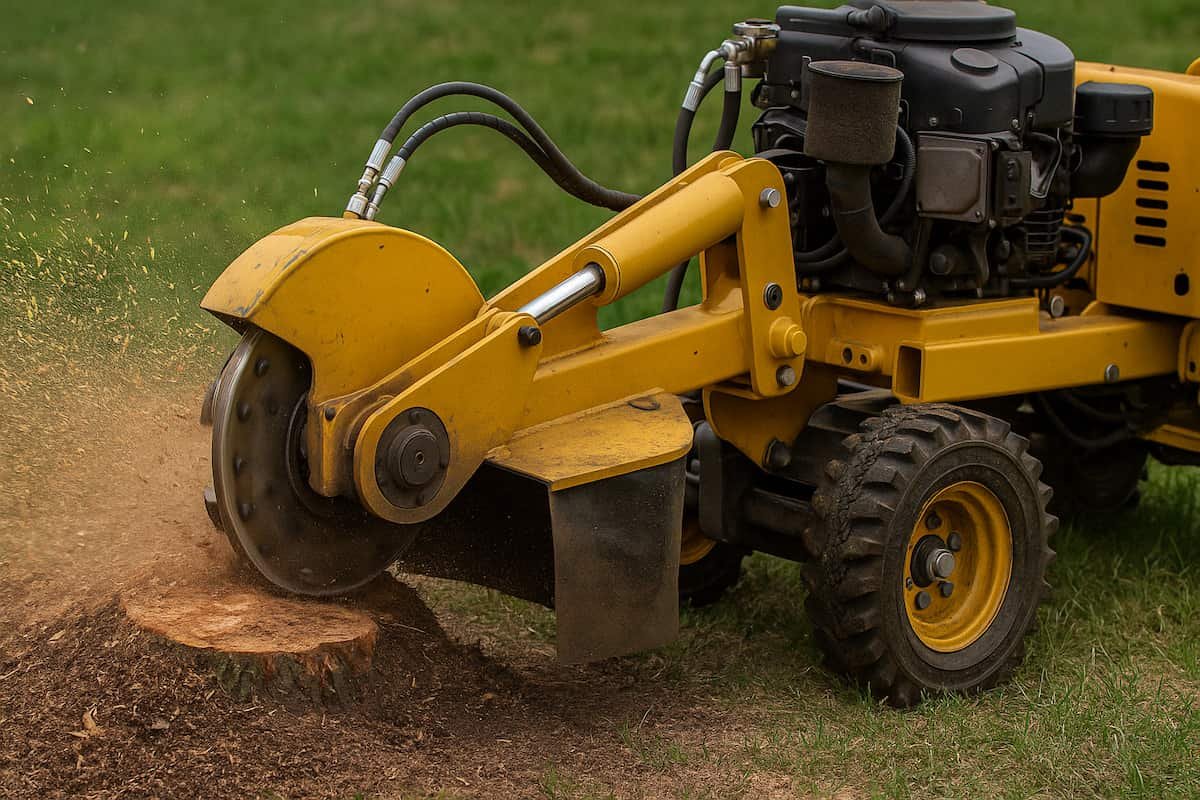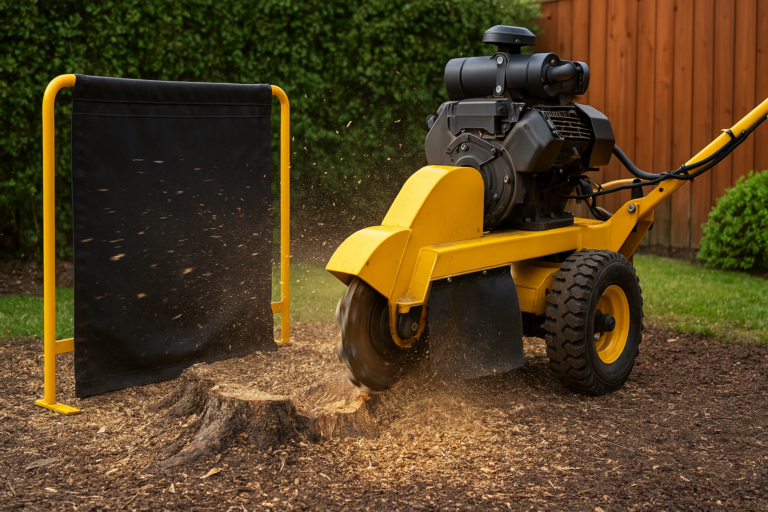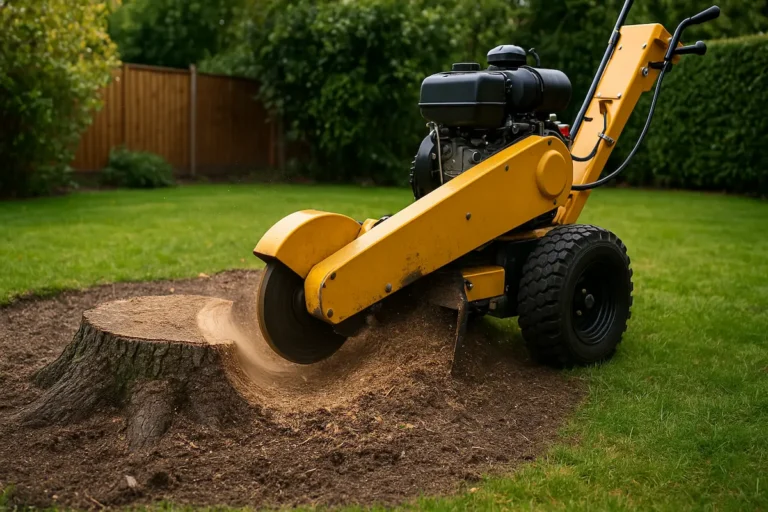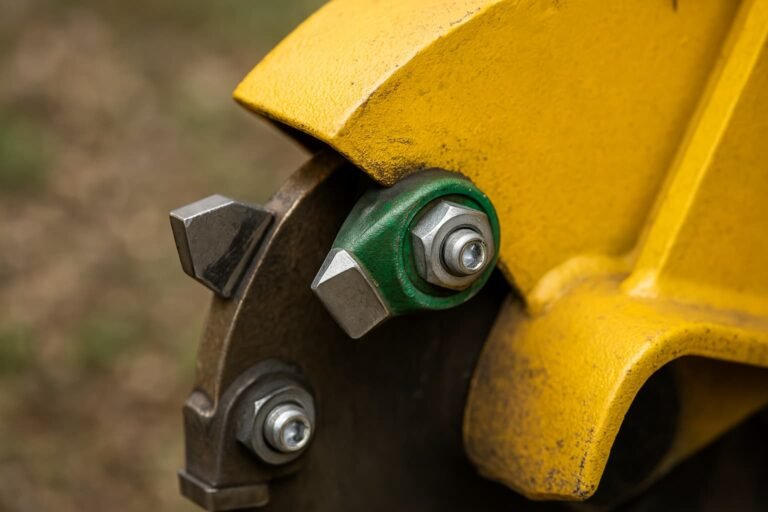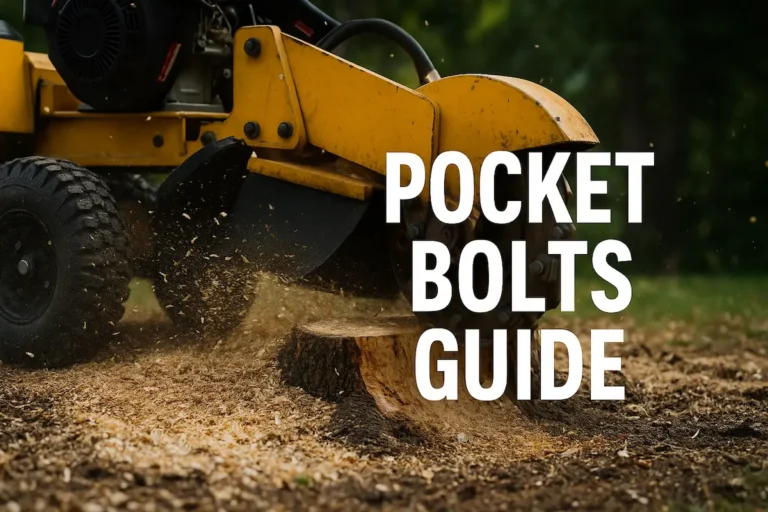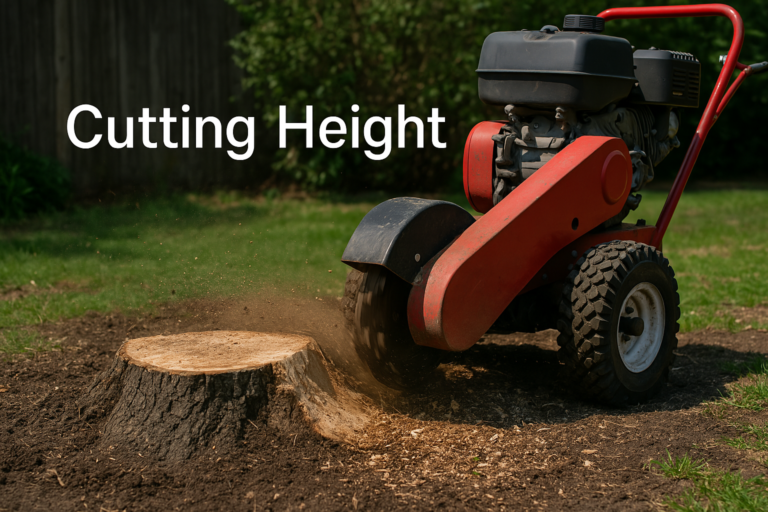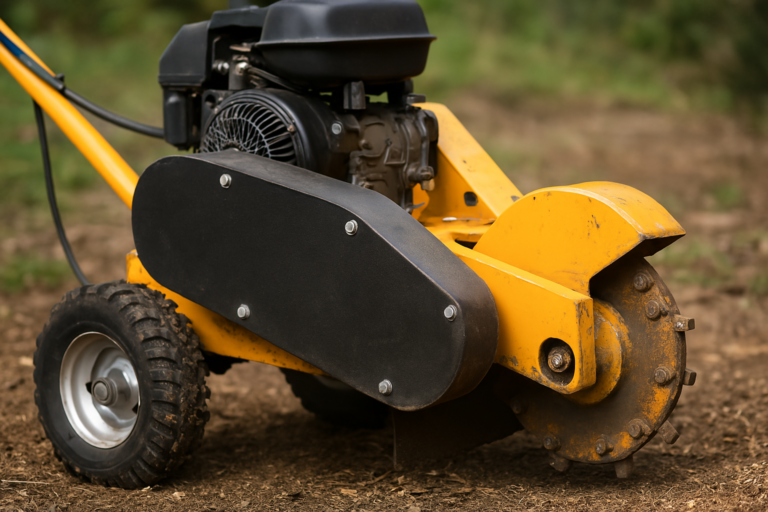Why Hire a Hydraulic Control Stump Grinder? Understanding the Power and Precision
Are you thinking about hiring a stump grinder now?
Are you wondering if a hydraulic control model is right for you?
These machines use special controls for more power and easier grinding.
Let’s see what that means for your job.
Key Takeaways: Hydraulic vs. Manual Stump Grinders
- Performance Gap: Hydraulic grinders significantly outperform manual models in cutting power, speed (especially on large/tough stumps), precision, and ease of operation.
- Operator Comfort: The reduced physical effort required for hydraulic machines makes them ideal for larger jobs or multiple stumps, minimizing fatigue.
- Precision Advantage: Smooth hydraulic controls allow for more accurate grinding, reducing the risk of damage to surrounding areas.
- Cost Consideration: Manual grinders are considerably cheaper to hire, making them a budget-friendly option for very small, easy-to-access stumps.
- Recommendation: For most typical hire scenarios involving medium-to-large stumps, hardwood, or multiple stumps, the efficiency and ease of a hydraulic grinder often justify the higher hire cost.
What is Hydraulic Control on a Stump Grinder?
Hydraulic control means the machine uses fluid pressure to move parts.
Think of it like the brakes on a car using fluid.
Instead of you pushing heavy levers hard, oil pressure does the work.
A pump pushes special oil through hoses.
This oil moves motors and cylinders.
These parts control the grinder’s actions.
On a stump grinder, hydraulics usually control:
- Cutting Wheel Sweep: Moving the sharp cutting wheel side to side across the stump.
- Cutting Wheel Lift/Lower: Moving the wheel up and down into the Wood.
- Depth Setting: Choosing exactly how deep you want to grind.
- Wheel Drive: Moving the grinder around your garden (on self-propelled ones).
- Other Parts: Some grinders use hydraulics to stabilise legs or chip guards.
You find hydraulic controls mostly on medium and large stump grinders.
These are often the professional machines you can hire.
They offer significant advantages over basic manual grinders.
The Main Benefit: Serious Grinding Power
The biggest reason to choose hydraulic is power.
Hydraulic systems create a lot of force.
This means the grinder can cut through big, tough stumps faster.
- Fact: Hydraulics give grinders strong, steady power.
- Result: You can grind large hardwood stumps that manual grinders struggle with.
Machine makers like Vermeer and Bandit show this in videos.
You see their hydraulic grinders cutting smoothly through huge stumps.
A manual grinder would take much longer and need more operator muscle.
Arborist forums often discuss this.
Many professionals say hydraulics are needed to earn money for grinding stumps.
They say moving from a manual to a hydraulic machine was a massive upgrade in speed.
User Experience:
“Switching to a hydraulic grinder cut my job time almost in half for bigger stumps. The power is just constant.”” (Paraphrased from forum comments)
Table: Power Comparison (General Idea)
| Feature | Manual Grinder | Hydraulic Grinder |
|---|---|---|
| Power Source | Operator Muscle / Small Engine | Engine driving Hydraulic Pump |
| Cutting Force | Lower, depends on operator effort | High, Consistent Force |
| Speed (Large Stumps) | Slower, more effort required | Faster, Less Operator Strain |
| Tough Wood | Can struggle or stall | Handles Hardwoods Effectively |
This extra power makes tough jobs much easier when you hire.
Getting Finer Control for a Better Finish
Hydraulic controls are not just about brute force.
They also give you exact control.
You can move the cutting head smoothly and gently.
This is much better than jerky movements from manual levers.
- Benefit: Smooth control means a cleaner, neater grind area.
- Benefit: You have exact command over where the wheel cuts.
- Benefit: The machine doesn’t jump around as much.
Online videos comparing grinders show this well.
Hydraulic models glide side-to-side smoothly.
Operators can make tiny adjustments easily with joysticks or levers.
This helps you grind up to edges or avoid roots you want to keep.
Imagine trying to colour neatly with a jerky crayon versus a smooth pen.
Hydraulics provide that smooth-pen feeling for grinding.
Hirer Feedback:
“The hydraulic controls on the hired grinder were brilliant. It’s so smooth compared to the manual one I used last year. Much less fighting the machine to get it right.” (Common sentiment from reviews)
This precision helps you do a professional-looking job.
It also reduces the chance of accidentally damaging surrounding areas.
Less Tiring Work: Let the Machine Take the Strain
Grinding stumps can be hard physical work.
Hydraulic controls make it much less tiring.
Operating hydraulic levers or joysticks takes minimal effort.
It’s like playing a video game compared to wrestling heavy handles.
Manual grinders often require you to push and pull the cutting head physically.
This gets exhausting quickly, especially with big stumps.
- Advantage: Significantly reduces operator fatigue.
- Result: You can work longer without getting worn out.
- Impact: It makes grinding multiple stumps much more manageable.
Many online reviews highlight this benefit.
Operators praise hydraulic machines for saving their backs and arms.
Videos show people controlling powerful machines with fingertip movements.
Manufacturers often mention “operator comfort” as a key feature.
This directly links to the reduced effort from hydraulic controls.
Professional View:
“Doing five large stumps daily used to wreck me with the old manual machine. With the hydraulic grinder, it’s tiring but nowhere near as physically demanding.” (Based on arborist forum discussions)
For a hire customer, this means you can tackle bigger jobs yourself.
You won’t feel completely exhausted after an hour.
Reduced fatigue also helps maintain focus, improving safety.
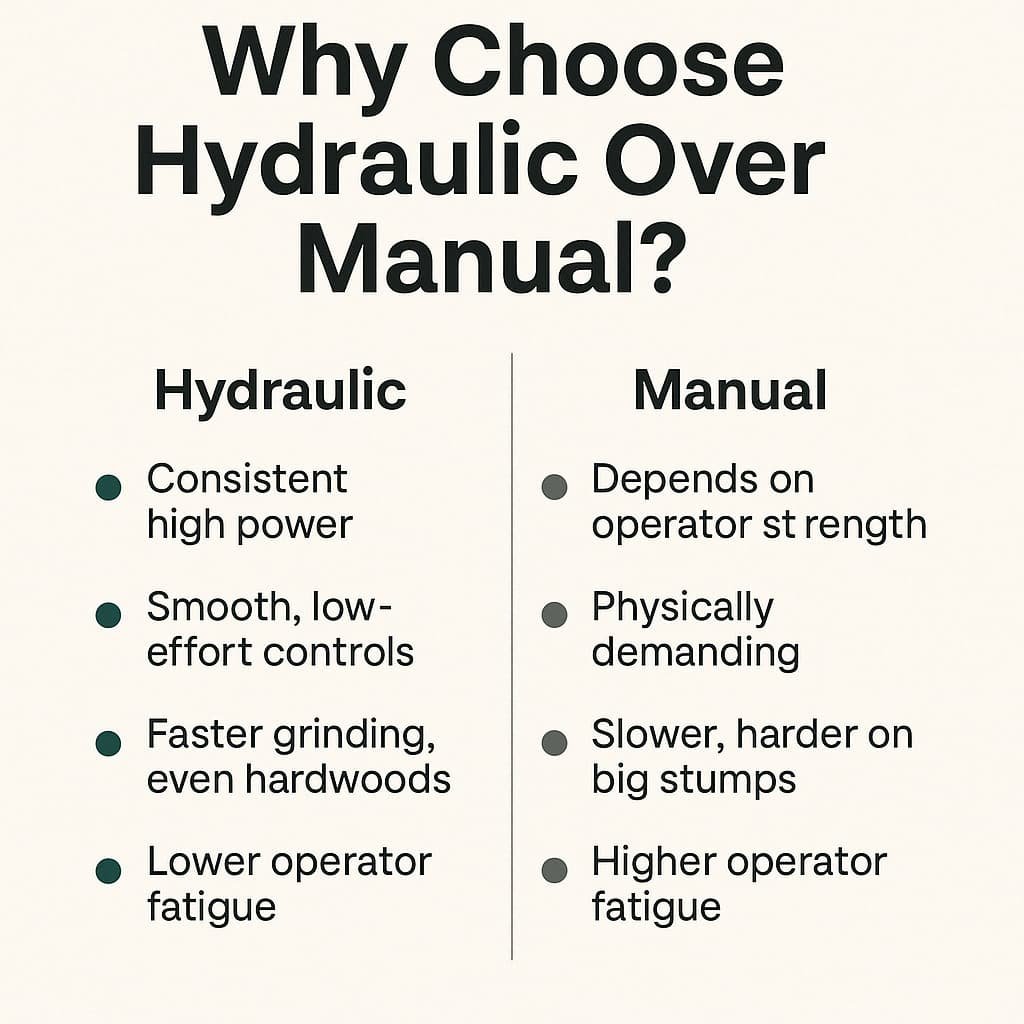
Are Hydraulic Stump Grinders Easy to Use When Hired?
This is a common question for first-time hirers.
Are these powerful machines complicated?
Generally, hydraulic controls can be quite user-friendly.
Once you understand what each lever or joystick does, it feels natural.
Often, you can control multiple movements at once smoothly.
For example, sweeping side-to-side while lowering the wheel slightly.
There is a slight learning curve.
You need a few minutes to get used to the controls’ sensitivity.
They react quickly compared to stiff manual levers.
But most people pick it up fast.
Think about driving a car for the first time – it takes some practice.
Important: A good hire company should show you the controls.
They will explain how everything works before you start.
- Tip: Ask for a quick demonstration when you collect the grinder.
- Tip: Start slowly in an open area to get the feel of it.
Many hire companies find customers prefer mid-size hydraulic grinders.
Even for DIY users, they are often easier for bigger jobs than struggling with a small manual unit.
Rental websites sometimes list “easy-to-use hydraulic controls” as a key feature.
So, don’t be put off by the term ‘hydraulic’.
They are designed to make the work easier and more efficient once you start.
Better Safety with Smooth Operation
Safety is always necessary when using powerful machinery.
Hydraulic controls can contribute to safer operation.
The smooth movements reduce sudden jerks or jumps.
This makes the machine’s behaviour more predictable.
Many modern hydraulic grinders have extra safety features linked to the controls.
- Operator Presence Control: If you let go of the joysticks, the machine might stop. This prevents runaway cutting.
- Remote Controls: Some giant professional machines use remote controls. The operator stands safely away from the cutting wheel. While you likely won’t hire these giant remote units, it shows how hydraulics enable advanced safety.
Always follow all safety instructions provided by the hire company.
Wear the correct Personal Protective Equipment (PPE).
- Eye Protection: Essential against flying debris.
- Hearing Protection: Grinders are loud.
- Sturdy Boots: Good grip and protection.
- Gloves: Improve grip and protect hands.
The smooth nature of hydraulic control adds an extra layer of predictable handling.
Things to Think About Before Hiring a Hydraulic Grinder
While hydraulic grinders are great, consider these points:
1. Higher Hire Cost:
Hydraulic machines are more complex and expensive to buy.
This usually means they cost more to hire than basic manual grinders.
You need to balance the extra cost against the time and effort saved.
- Action: Compare hire prices for manual vs. hydraulic models.
- Question: Is the time saved worth the extra money for your specific job?
2. Importance of Good Maintenance:
Hydraulic systems have more parts: pumps, hoses, valves, and oil.
They need good maintenance to work reliably.
Hoses can leak, valves can stick, and pumps can fail if not looked after.
- Risk: A poorly maintained hire machine could break down mid-job.
- Evidence: Online forums sometimes have stories of hydraulic issues on hire equipment.
Common Complaint: “Hired a grinder and a hydraulic hose burst. Big mess and lost half a day’s work.” (Paraphrased from user forums)
- Solution: Choose a reputable hire company known for well-maintained equipment. Ask about their maintenance checks.
3. Needing a Little Practice:
As mentioned, the controls are sensitive.
Don’t expect to be an expert in the first 60 seconds.
Allow yourself 5-10 minutes of practice time.
Get used to how quickly the machine reacts to your inputs.
- Tip: Avoid using it near delicate objects until you feel confident.
These points aren’t to scare you off.
They are just realistic things to keep in mind.
For most people tackling medium to large stumps, the benefits heavily outweigh these considerations.
Quick Look: Common Hydraulic Grinder Hire Issues & Solutions
| Potential Issue | Why it Happens | How to Avoid/Mitigate (as a Hirer) |
|---|---|---|
| Hydraulic Fluid Leak | Old/damaged hoses, loose fittings | Hire from a company with well-maintained gear. Do a quick visual check for obvious leaks before starting. |
| Jerky/Slow Controls | Low fluid, air in system, valve issue | Report immediately to hire company. Indicates maintenance needed. |
| Loss of Power | Pump issue, clogged filter, low fluid | Check fluid level (if accessible/instructed). Report to hire company. |
| Control Confusion | User unfamiliarity | Ask for clear instructions. Take a few minutes to practice away from obstacles. Start slowly. |
Real User Experiences: What People Say Online
Looking at online comments gives a good picture.
YouTube:
- Lots of Positives: Videos show operators grinding big stumps fast. Comments say things like:
- “Makes quick work of big stumps.“
- “Couldn’t do my job without hydraulics.”
- “The smooth control is amazing.”
- Some Challenges: Repair videos discuss fixing leaks or control problems. Some comments mention:
- “Takes getting used to; controls are sensitive.”
- Frustration if a hire machine breaks down.
Arborist Forums (like ArboristSite and Tree Buzz):
- Professionals Love Them: Most pros agree hydraulics are essential for serious work. They often compare control systems between brands.
- Example Post: “Grinding on a slope today, the hydraulic drive and fine wheel control were vital. Impossible with my old manual grinder.” (Paraphrased)
- Maintenance Reality: There have been many discussions about fixing hoses and valves and the cost of repairs. This highlights the need for reliable machines, especially for hire.
Reddit (Gardening/Arborist Groups):
- Similar comments to forums.
- People often ask if hydraulic is “worth it” for their garden job.
- General answer: Yes, for more than one or two tiny stumps.
- Some mention good or bad hire experiences, often linked to machine maintenance.
Overall: Most people who use hydraulic grinders appreciate the power and control. The main concerns revolve around cost and the need for good maintenance by the hire company.
Case Study Examples (From Online Sources)
Let’s look at typical scenarios where hydraulic grinders shine:
- Case 1: Large Garden Clearance
- A YouTube video shows a landscaper hiring a mid-size hydraulic grinder.
- They need to remove several large, old tree stumps.
- The video highlights the easy hydraulic manoeuvring around the garden.
- The precise hydraulic sweep control removes the stumps quickly without wrecking the lawn.
- Conclusion: The job is much faster and neater than a manual grinder.
- Case 2: Professional Land Clearing
- An arborist forum post describes using a large, tracked hydraulic grinder.
- The job involves clearing many stumps from a building site.
- The hydraulic power is essential for speed.
- The hydraulic tracks allow working on rough, muddy ground.
- Conclusion: Hydraulics necessary for commercial speed and capability.
- Case 3: Grinding in a Tight Spot
- A review website mentions using a smaller hydraulic grinder (like a Toro STX).
- The stump was close to a fence and flowerbeds.
- The sensitive hydraulic controls allowed careful movement.
- They could grind precisely without damaging the wall.
- Conclusion: Hydraulic precision was key in the confined space.
These examples show how the benefits – power, control, manoeuvrability – apply in real jobs.
When Should You Hire a Hydraulic Stump Grinder?
Deciding between manual and hydraulic? Here’s a guide:
Hire a HYDRAULIC grinder if:
- You have large stumps: Hydraulics make it much easier to make anything wider than 30-40 cm (12-16 inches).
- You have Hardwood Stumps: Oak, beech, or other dense woods require more power. Hydraulics provide that consistent force.
- You have Multiple Stumps: Grinding several stumps is much less tiring with hydraulic controls. The time saved adds up.
- Time is Limited: If you want the job done as quickly as possible, hydraulics offer faster grinding speeds.
- You Want Less Physical Effort: If you prefer not to wrestle with a heavy machine, hydraulics’ more effortless operation is a significant plus.
- Access Requires Driving the Machine: If you need a self-propelled grinder to reach the stump (not just push it), these usually have hydraulic drive, which is powerful and controllable.
A manual grinder might be okay if:
- You only have one or two tiny stumps (under 20-30 cm / 8-12 inches).
- The stumps are soft Wood (like pine).
- Your budget is very tight, and you have plenty of time and energy.
Think about:
- Stump Size: How wide and tall are they?
- Wood Type: Softwood or tough hardwood?
- Number of Stumps: Just one, or a whole garden full?
- Your Time: How quickly do you need it done?
- Your Budget: Is the extra hire cost worth the saved effort?
- Access: Can you push a manual machine or need powered wheels?
Answering these helps you choose the right tool for your specific situation.
For many typical stump removal jobs that lead people to hire a grinder, the hydraulic option often provides better value due to saved time and effort.
Choosing Your Hydraulic Grinder Hire Here
We understand the importance of reliable, powerful equipment.
At treestumpgrinderhire.com, we aim to provide well-maintained hydraulic stump grinders.
We know you want a machine that works hard, so you don’t have to.
- Our Commitment: We regularly check and service our hydraulic machines. This reduces the chance of breakdowns during your hire.
- Clear Instructions: When you pick up the grinder, or we deliver it, we’ll happily show you how to operate the hydraulic controls safely and effectively.
- Matching Machine to Job: We can help you decide if a hydraulic model best fits the stumps you need to remove.
We want your stump grinding project to be successful and hassle-free.
Using a powerful and precise hydraulic grinder from our fleet can make a big difference.
Conclusion: Use Hydraulic Power for Easier Stump Removal
Hydraulic control makes stump grinders much more powerful and easier to handle.
They use fluid pressure to move the cutting wheel and drive the machine.
This means less physical work, faster grinding, and smoother control.
Hydraulic grinders are excellent for large stumps, hardwood, or multiple stumps.
While hiring costs a bit more, they save significant time and effort.
Next Steps:
- Assess Your Job: Measure your stumps and note the wood type.
- Consider Your Needs: Think about time, effort, and budget.
- View Our Machines: Check out the hydraulic stump grinders available for hire on our website.
- Ask Us: Contact us if you need help choosing the right grinder for your project.

